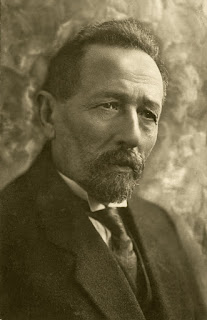DOVID-YESHAYE
ZILBERBUSH (DAVID ISAIAH SILBERBUSCH)
(December 4, 1854-March 1, 1936)
He was born in Zaleshtshiki (Zalishchyky),
eastern Galicia. He attended religious
elementary school, later studying Talmud with commentaries on his own. He married at age twenty the daughter of a
wealthy Jewish landowner, and he both studied Judaism and surreptitiously read
irreligious writings. Within six months
he became a widower and returned alone to his hometown where for appearance
sake he studied in the synagogue study hall, but in the main he was now turning
his attention to the Jewish Enlightenment.
Later, he married a second time in Kolomaye, while living as a guest of
his in-laws and studying Hebrew and German literature. He later traveled to Vienna where he made the
acquaintance of Perets Smolenskin, helped him by reading proofs of Hashaḥar (The dawn) and
also proofread Kohut’s Arukh hashalem
(Complete set). From 1882 he was living
in Botoșani,
Romania, and from there moved to Lemberg.
In 1893 he was a religion teacher in the Kolomaye state school; later
still he settled in Vienna where he also was living at the time of WWI. In 1927 he visited the United States and in
1928 Poland. He traveled frequently and
attended virtually all the Zionist Congresses.
He began writing in 1878 in Smolenskin’s Hamabit (The observer), in which he published stories and
articles. He wrote an article on Jews in
Galicia and a feature piece for Hashaḥar
(vol. 10). He also contributed to: Avrom
Gintsler’s Hator (The turtle-dove) in
Kolomaye, Hamelits (The advocate), Hatsfira (The siren), Broydes’s Hayahadut (Judaism), Keneset yisrael (Congregation of Israel),
Hamagid haḥadasha
(The new preacher), Sefer hashana
(Yearbook), Haeshkol (The cluster),
and Mimizraḥ umimaariv (From the
east and from the west), among others. He
began writing in Yiddish in 1892, and he published articles, feature pieces,
and stories in: Der yud (The Jew); Lemberger togblat (Lemberg daily
newspaper) and Nayes lemberger togblat
(New Lemberg daily newspaper), edited by G, Bader (1909); Yudisher viner morgntsaytung (Jewish Viennese morning newspaper)
and Viner morgnpost (Viennese morning
mail) during WWI; Yidishes tageblat
(Jewish daily newspaper) in New York; the Perets issue of Literarishe bleter (Literary leaves) in Warsaw (1915); and
others. In Botoșani he and Tsvi-Leyzer
Teler published in 1882 the Hebrew-language monthly journal Haor (The light), which he later
published alone in Lemberg. In Kolomaye
he published and edited a Hebrew biweekly work entitled Haam (The people) in 1893 and the Yiddish-language Folks blat (People’s newspaper), which
he wrote most of it over the course of six months. In book form in Yiddish: Shtrekhalekh fun der milkhome-tsayt (Blows from the war years),
stories and sketches (Vienna, 1916), 176 pp.; Skitsn (Sketches), impressions and humorous sketches from Jewish
life in Galicia, Marienbad notes, and a perspective on the life of Velvl
Zbarzher (Ehrenkrants) (Vienna: Literarishe fraynd, 1921),117 pp.; Menshen un gesheenishn (People and
events) (Vienna, 1931), 94 pp., including a chapter of reminiscences about
Goldfaden which, according to Dr. Y. Shatski, is constructed more on
information taken from published works about Goldfaden than his own factual
memoirs. In book form in Hebrew: Koaḥ habit (The daughter’s strength),
memoirs (1885); Ḥadashim gam yeshanim
(Old and new) (1890); Dimat ashukim
(Tear of the oppressed) (1891); Nefesh aḥat
miyisrael (One Jewish life) (1894); Maḥazot
veshivre maḥazot (Plays and fragments of plays) (1900); Maḥazot vesipurim (Plays and stories)
(1920); and Ketavim nivḥarim
(Selected writings) (1920). He also
published under the pen names: Ish-Yeshuda, Ben-Yisrael, Hadani, and
Zevadi. His seventieth birthday was
celebrated in Vienna in 1924, and his eightieth birthday in 1934 in Israel. His memoirs constitute a major cultural
historical work. He died in Israel. Zilberbush’s language is rich with Galician
Yiddish idioms.
Sources:
Zalmen Reyzen, Leksikon, vol. 1; Y.
Shatski, Hundert yor goldfaden (A century of Goldfaden) (New York: YIVO,
1940), pp. 107-8; Y. Shteynberg, in Reshumot
(Tel Aviv) (1928), pp. 191-93; Gershon Bader, Medina veḥakhameha (The state and its sages) (New York, 1934), see index; Bader, Mayne zikhroynes (My memoirs) (Buenos Aires,
1953), see index; Y. Braynin, in Tsukunft
(New York) (February 1930); M. Ribalov, in Hadoar
(New York) (February 7 and March 6, 1936); Ben-Moyshe, in Poylishe yidn (Polish Jewry), yearbook (New York, 1936), p. 42; Y. Likhtnboym, in the anthology Hasipur haivri (The Hebrew
story) (Tel Aviv, 1955), p. 518; Sefer
haishim (Biographical dictionary) (Tel Aviv, 1936/1937), p. 568; N. M.
Gelber, in Pinkes kolomay (Records of
Kolomaye) (New York, 1957), pp. 67-68; M. Ravitsh, Mayn leksikon (My lexicon), vol. 3 (Montreal, 1958), p. 476.

No comments:
Post a Comment